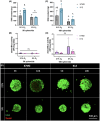Extracellular matrix production and oxygen diffusion regulate chemotherapeutic response in osteosarcoma spheroids
- PMID: 39300969
- PMCID: PMC11413413
- DOI: 10.1002/cam4.70239
Extracellular matrix production and oxygen diffusion regulate chemotherapeutic response in osteosarcoma spheroids
Abstract
Background: Osteosarcoma (OS) survival rates and outcome have not improved in 50 years since the advent of modern chemotherapeutics. Thus, there is a critical need for an improved understanding of the tumor microenvironment to identify better therapies. Extracellular matrix (ECM) deposition and hypoxia are known to abrogate the efficacy of various chemical and cell-based therapeutics. Here, we aim to mechanistically investigate the combinatorial effects of hypoxia and matrix deposition with the use of OS spheroids.
Methods: We use two murine OS cell lines with differential metastatic potential to form spheroids. We form spheroids of two sizes, use ascorbate-2-phosphate supplementation to enhance ECM deposition, and study cell response under standard (21% O2) and physiologic (5% O2) oxygen tensions. Finally, we examine chemotherapeutic responses to doxorubicin treatment.
Results: ECM production and oxygen tension are key determinants of spheroid size through cell organization based on nutrient and oxygen distribution. Interestingly, highly metastatic OS is more susceptible to chemotherapeutics compared to less metastatic OS when matrix production increases. Together, these data suggest that dynamic interactions between ECM production and oxygen diffusion may result in distinct chemotherapeutic responses despite inherent tumor aggressiveness.
Conclusion: This work establishes OS spheroids as a valuable tool for early OS tumor formation investigation and holds potential for novel therapeutic target and prognostic indicator discovery.
Keywords: chemoresistance; chemotherapy; hypoxia; osteosarcoma; tumorigenesis.
© 2024 The Author(s). Cancer Medicine published by John Wiley & Sons Ltd.
Conflict of interest statement
The authors declare no conflicts of interest.
Figures








